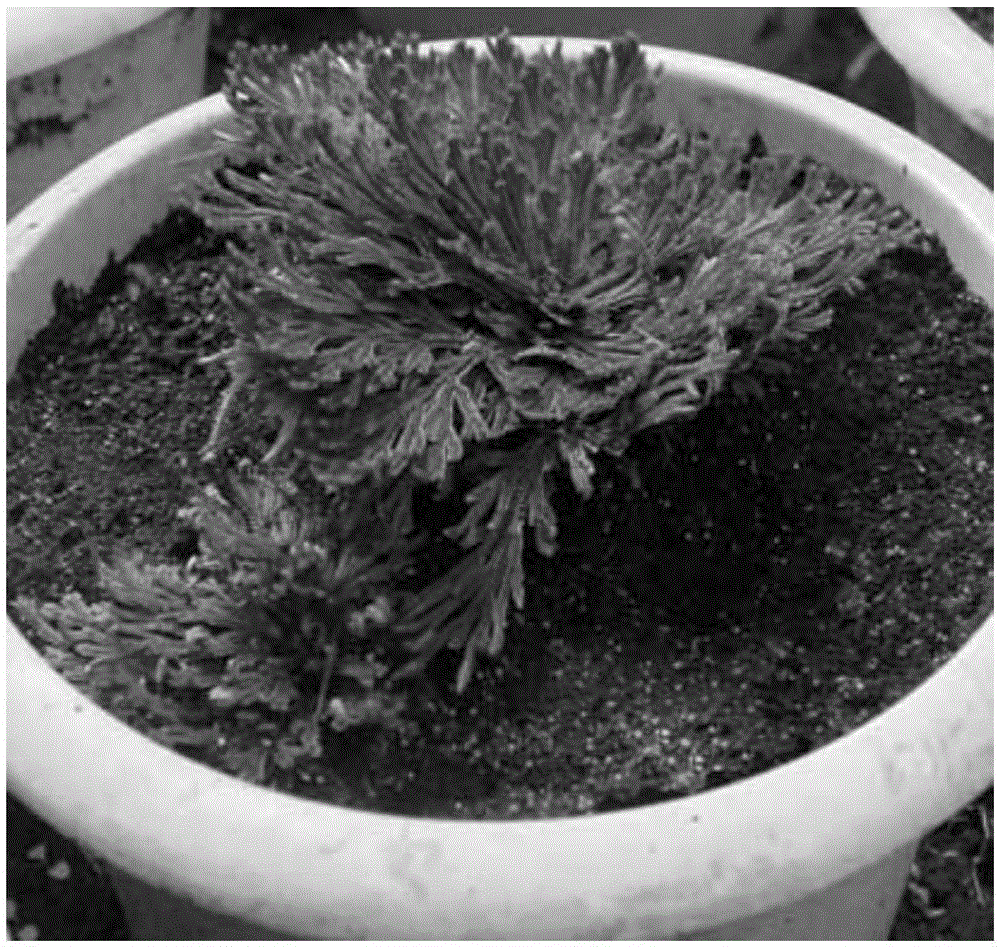Introduction and cultivation method of selaginella tamariscina
A cultivation method and technology of Selaginella, applied in the field of plant cultivation, can solve the problems of long germination time, low germination rate and seedling rate, and reduced survival rate of Selaginella introduction and cultivation, and achieve vigorous plant growth and simple and easy operation Effect
- Summary
- Abstract
- Description
- Claims
- Application Information
AI Technical Summary
Problems solved by technology
Method used
Image
Examples
specific Embodiment approach 1
[0032] Specific implementation mode one: the introduction and cultivation method of Selaginella chinensis in the northern region is completed by the following steps in the present implementation mode:
[0033] Step 1. Collection of transplanted plants: At the beginning of September every year in the northern region, select large and medium-sized Selaginella plants with individual large and medium-sized, bright green color, plant extension, and no incompleteness in the forest or rock crevices on the hillside for collection. Keep the underground parts of the plants and avoid damage, and at the same time collect the understory humus at the original collection site, and collect the Selaginella plants and place them in a cool and ventilated place;
[0034] Step 2, transplanting: within 3-5 days after collection, transplant the Selaginella plants with permanent soil into the potted culture medium, place them in the greenhouse, control the planting depth at 10-15cm, and water once on ...
specific Embodiment approach 2
[0038] Specific embodiment two: this embodiment is different from specific embodiment one: adopt humus, peat moss and fine sand combination to replace the culture medium described in step two, the volume ratio of humus, peat moss and fine sand is 10:2:1. Other steps and parameters are the same as in the first embodiment.
[0039] In step 3, the sunshine time in winter is less than 8 hours, and the 60w diffused light supplementary light is used to supplement the light so that the light time is 10 hours, and the light intensity is 170μmol·m -2 ·s -1 , The diffused fill light is set at a height of 2 meters above the plants, the shade net is removed when the light is filled, and the shade net is covered when the sun shines.
specific Embodiment approach 3
[0040] Specific embodiment three: the introduction and cultivation method of Selaginella chinensis is completed by following steps in the present embodiment:
[0041] Step 1. Collection of transplanted plants: it can be collected all year round in the southern region. Select large and medium-sized Selaginella plants with bright green color, stretched plants, and no incomplete individuals in the forest or rock crevices on the hillside for collection. Soil, keep the underground parts of the plants and avoid damage, and at the same time collect the leaf humus from the original collection place;
[0042] Step 2. Transplanting: within 7 days after collection, transplant the Selaginella plants with permanent soil into the culture medium, control the planting depth at 10-15cm, and the shading rate is 65%-75%. Water once on the day of planting ;
[0043] Step 3, management and cultivation after transplanting: the shading rate is controlled at 65%-75%, the cultivation temperature is c...
PUM
 Login to View More
Login to View More Abstract
Description
Claims
Application Information
 Login to View More
Login to View More - R&D
- Intellectual Property
- Life Sciences
- Materials
- Tech Scout
- Unparalleled Data Quality
- Higher Quality Content
- 60% Fewer Hallucinations
Browse by: Latest US Patents, China's latest patents, Technical Efficacy Thesaurus, Application Domain, Technology Topic, Popular Technical Reports.
© 2025 PatSnap. All rights reserved.Legal|Privacy policy|Modern Slavery Act Transparency Statement|Sitemap|About US| Contact US: help@patsnap.com

